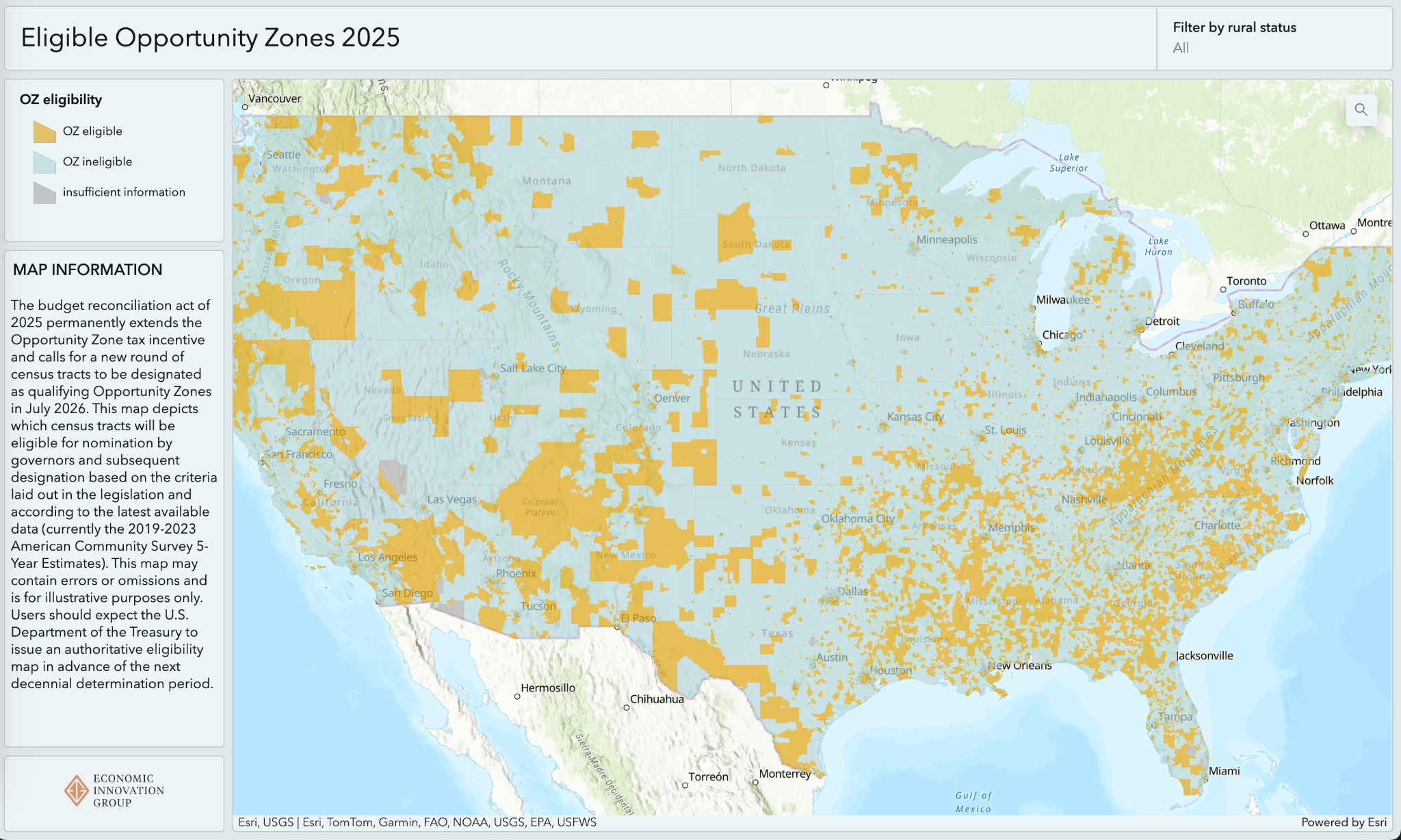By John Lettieri, Kenan Fikri, and Catherine Lyons
Key Points
- The One Big Beautiful Bill Act (OBBBA) makes Opportunity Zones (OZ) a permanent pillar of U.S. economic development policy, with decennial redesignation cycles that will enable governors to refresh the map of targeted communities according to current economic conditions on a predictable schedule.
- The OBBBA does more than simply make the OZ incentive permanent. It streamlines the structure of the incentive to provide certainty and neutrality, ensuring that all investors receive the same benefit for investing in a given area no matter when their investment occurs.
- The new OZ benefit structure heavily favors rural over non-rural investment, offering triple the standard step-up in basis benefit (30 percent versus the standard 10 percent) for investments made in a newly-created class of rural qualified opportunity funds, in addition to cutting the “substantial improvement” test in half for investments in rural areas.
- The OBBBA also significantly tightens the requirements that determine which places are eligible for OZ designation, which will lead to a much smaller map of OZ communities in the next round of designations taking effect in 2027.
- OZ investments will now be subject to sweeping reporting and transparency requirements, and Treasury will be obligated to publish annual reports on OZ investments, along with semi-regular reports tracking the economic performance of designated communities compared to similar, non-designated areas.
Introduction and Background
Opportunity Zones (OZ) were originally enacted as a one-off tax policy experiment in the 2017 Tax Cuts and Jobs Act (TCJA). Nearly eight years and $100 billion in investment later, the incentive has been made a permanent part of the federal tax code via the One Big Beautiful Bill Act (OBBBA), signed into law by President Trump last week.
A Different Approach to a Familiar Priority
The premise of the OZ incentive was simple and, in broad terms, similar to an array of previous federal programs like the New Markets Tax Credit (NMTC), Enterprise Zones (EZ), and Renewal Communities (RC): use tax incentives to encourage private investment in low-income and high-poverty areas. Nevertheless, the design of the OZ policy was a fundamental—and somewhat radical—departure from those previous efforts.
Opportunity Zones were designed to prioritize speed, scale, market knowledge, and an uncapped and back-loaded benefit that required investors—not the U.S. taxpayer—to use their own capital and absorb essentially all of the risk. This was a stark contrast to the more traditional community development tax credit model that front-loads all-but-guaranteed benefits to investors regardless of the ongoing viability of the investments themselves. The OZ incentive, as a result, has filled a gap in the federal economic development toolkit, drawing equity capital from a different class of investors than have typically participated in legacy programs.
Early Results
The early results have largely validated the policy’s fundamental design. Opportunity Zones have spurred more private capital across a wider array of low-income communities than any previous policy over such a short period of time. Through the end of 2022 alone, $89 billion in qualifying equity investments had been made across over 5,600 low income neighborhoods, with most estimates suggesting that investment in the first round of designations will eventually total well over $100 billion.
The community-level effects of the incentive can be observed most clearly in the housing sector, where OZ investment has led to a surge in much-needed supply, turning areas that have been chronic laggards in housing production into national leaders. An EIG working paper finds that OZs were responsible for a net increase of 313,000 housing units over a five-year period between Q3 2019 and Q3 2024 above and beyond what would have otherwise occurred—an effect that is still growing significantly in the latest available data. As a result of this sharp change in trajectory, OZ communities surged ahead of non-designated areas in their rate of housing production.
Other research examining 12,000 census tracts across 47 large cities finds that OZ designation had a “large and immediate” effect on development activity, with positive spillovers to neighboring non-designated tracts. OZ designation also raised housing values without any corresponding increase in rents.
While the longer-term effects on employment, business establishments, income, and poverty are not yet clear, the question of whether the OZ incentive would lead to net new activity or simply reward activity that would have happened anyway has been answered.
Key Features of OZ 2.0
With the TCJA-enacted Opportunity Zones approaching its statutory expiration date, the core question facing lawmakers was whether to simply extend the incentive (as the House initially opted to do) or instead make it permanent.
What emerged in the OBBBA is a true “2.0” version of Opportunity Zones, with substantial modifications to the policy’s geographic targeting criteria, incentive structure, and reporting requirements—all made on a permanent basis.
Permanent Incentive, Evolving Geographies
The OBBBA makes the OZ incentive permanent and establishes a redesignation cycle to update the map of designated communities every 10 years. The next designation cycle will begin on July 1, 2026, when governors will begin nominating a new map of census tracts. Once the Secretary of the Treasury certifies those tracts, the new map of Opportunity Zones will go into effect on January 1, 2027, and last for 10 years, after which it will be replaced with updated designations on a decennial basis.
The current OZ map will remain in effect through the end of 2028, meaning that it will overlap with the new round of designations for two years. (The House bill would have sunset the current map at the end of 2026—two years early—but that provision was removed in the final bill.)
New Targeting Criteria
As was the case in the original OZ statute, governors may select up to 25 percent of their states’ eligible tracts, with a 25-tract minimum. Importantly, governors maintain full discretion when nominating tracts for OZ status. (The House version of OBBBA would have mandated a 33 percent set-aside for rural designations, but that mandate was removed before final passage.)
The TCJA-enacted version of Opportunity Zones used the same “low-income communities” (LIC) definition for eligibility that was established in the New Markets Tax Credit (NMTC) program. The OBBBA imposes new, stricter criteria for OZ eligibility. For future rounds of designation, a census tract will need to satisfy one of the following tests:
- Median family income (MFI) below 70 percent of the state (non-metro) or metro (metro areas) median (versus 80 percent in the original OZ provision).
- Poverty rate of 20 percent or greater (unchanged), plus a newly-established MFI cap set at 125 percent of the applicable state or metro median. The MFI cap closes a statistical loophole that allowed a small number of high-income census tracts to qualify for OZ status.
A map of all eligible census tracts based on these criteria and the most current American Community Survey 5-Year Estimates for 2019-2023 is available through the interactive dashboard below.
Smaller Map
The number of designations in the new 2027 OZ map is likely to be significantly smaller than in the current OZ map primarily thanks to the stricter MFI test. Looking exclusively at the 50 states and D.C., we estimate a 19.5 percent reduction in the number of OZ designations in the upcoming round, dropping from 7,826 to 6,304 (and from 8,764 to an estimated 6,555 including territories).
Several states see much larger declines than the national average, such as Minnesota (-42 percent), Nebraska (-36 percent), and Oregon (-36 percent). Ten states would see no reduction in designations thanks to the 25-tract minimum rule.
Given that Congress prioritized boosting OZ 2.0 tax benefits for investments in rural communities, it is noteworthy that the new targeting rules will disproportionately exclude rural communities that would have otherwise qualified for designation.
More Distressed Pool of Census Tracts
The stricter targeting criteria will not only result in a smaller map, but also a more distressed one.
The average OZ-eligible census tract has a poverty rate more than twice the national figure, compared to 1.68-times for TCJA-era designations. Similarly, the median family’s income in the average eligible tract is now only 59 percent of the national figure, compared to 65 percent before. The typical eligible tract is also more diverse now, paralleling the nation’s demographic evolution. TCJA-era OZ designations were already more distressed across the board than the class of eligible low-income tracts generally; the OZ map going forward is likely to be even more targeted towards the neediest communities.

Deleted Provisions
Some of the original OZ eligibility provisions have been removed entirely. The TCJA contained a special rule for Puerto Rico that automatically designated all eligible tracts. The OBBBA drops this provision. Likewise, the TCJA targeting rules allowed governors to use up to five percent of their selections on certain tracts that were adjacent to a designated LIC, but did not themselves meet the core income or poverty LIC criteria. (In the end, roughly two percent of all OZ tracts were designated under this exception.) This too has been removed.
New Incentive Structure
The OBBBA modifies the core OZ incentive structure in ways that ensure greater certainty, simplicity, and fairness.
Under the original OZ model, taxpayers could receive three tax benefits for investing their unrealized capital gains in Qualified Opportunity Funds (QOF), which are special-purpose funds designed to invest in OZ communities. Those three tax benefits are:
- A deferral on their original capital gains recognition until December 31, 2026;
- A step-up in basis on their original gains of up to 15 percent;
- Tax-free growth on their investment if held for 10 years or more.
While the tax-free growth on new gains from an investment in a QOF were available no matter when a taxpayer invested, the first two benefits—the deferral and the step-up—decayed over time, meaning that only very early investors could achieve the full range of benefits. This kept the cost of the provision low by ensuring that the bulk of deferred tax revenue would be recaptured within the 10-year congressional scoring window. It was, however, far from ideal from an economic or tax policy standpoint, and has resulted in a steady wind-down in the amount of new investment going into QOFs as the value of the tax benefits have diminished.
The most important new feature of OZ 2.0—mirroring one of EIG’s top policy recommendations—is a streamlined benefit structure that ensures all investors receive the same benefit no matter when their investment occurs. Instead of a deferral that steadily winds down over time, all OZ investors will receive a standard, five-year deferral accompanied by a 10 percent step-up in basis on their original investment. No more benefit decay, no more timing cliffs.
Standardizing the deferral benefit will help ensure consistent investor participation over time, making it easier to maintain momentum for local revitalization efforts.
Meanwhile, the OBBBA maintains the core OZ benefit: tax-free growth for investments held 10 years or more. If an investor holds for 30 years, they must now take a new basis equal to fair market value at that time.
Rural Enhancements
The OBBBA significantly enhances the OZ 2.0 tax benefit for rural investments.
First, it establishes a new class of opportunity funds—Qualified Rural Opportunity Funds (QROFs)—through which investors can receive a 30 percent step-up after five years, versus the 10 percent standard step-up.
QROFs must invest at least 90 percent of their assets in rural OZ tracts, which the statute defines as any area not in or immediately adjacent to a town with at least 50,000 inhabitants. (We should note that this was a somewhat puzzling definitional choice since it does not cleanly apply at the census tract level, presenting Treasury with extra administrative burden in determining which areas satisfy the definition.) The interactive eligibility map linked to above includes a rural filter based on our best anticipation of Treasury’s read of the rule.
The OBBBA also lowers the “substantial improvement” test threshold for rural investments by half. Typically, an OZ investment must either be new (“original use”) or improve the value of an existing asset by doubling its adjusted basis over a 30-month period (“substantial improvement”). Under the OZ 2.0 rules, that 100 percent improvement threshold is reduced to 50 percent, which could make many otherwise non-qualifying investments eligible for the OZ benefit. This is consistent with stakeholder feedback Congress received about how to better align the incentive structure with the economics of rural investments.
Delayed Effective Date for New Benefits
The OZ 2.0 tax benefits do not take effect until January 1, 2027—the same day the new OZ map takes effect. This creates an unfortunate disincentive for OZ investment during the intervening period, because a taxpayer can achieve a much stronger benefit by waiting until the new rules are in effect. As a result, we expect a relative “dead zone” of OZ investment for the next 18 months, with potentially harmful consequences for projects that are currently still fundraising and for communities that had hoped to see a renewed surge of activity following passage of the OBBBA.
Reporting Requirements
Another major change is the OBBBA’s inclusion of sweeping reporting and transparency requirements for OZ investment activity—something long sought-after by the policy’s supporters and critics alike. Treasury will now be required to issue annual public reports that detail the number of QOFs and their total assets, the number of designated tracts with confirmed investment, and details on investment sectors, housing units created, employment impacts, and more. In years six and 11 after enactment, Treasury will also be required to issue reports assessing the socioeconomic performance of designated tracts versus comparable, non-designated areas using indicators like job creation, poverty rates, income, housing, and business formation. These public disclosures will dramatically improve the quality and timeliness of information related to the policy, helping to inform local implementation efforts as well as future improvements to the policy itself.
Unfinished Business: What Got Left Out of OZ 2.0?
While a permanent and improved incentive structure is a major achievement, there had been hope among OZ stakeholders that the OBBBA would go further in expanding the key features of the incentive and correcting for serious shortcomings in the way the policy was originally implemented.
The most glaring omission was the lack of any technical improvements to ensure that investments in non-real estate operating businesses are no longer disadvantaged—a well-known shortcoming in the current rules governing qualifying OZ activity. Other consensus priorities for stakeholders, such as broadening participation by making non-capital gains (i.e., “ordinary income”) eligible, allowing a “fund-of-funds” structure for QOFs to aggregate and deploy capital, enhancing the role of Community Development Financial Institutions in the OZ ecosystem, or easing the rules for certain affordable housing investments, were also left unaddressed.
The action now moves to the regulatory and rule-writing phase, where it is possible that some technical improvements can be made in areas where the statute gives the IRS broad discretion.
Conclusion
Only ten years after the white paper that introduced the Opportunity Zones concept to the world, the policy has gone from a successful experiment to a permanent fixture of the federal tax code.
The changes made to the policy in the OBBBA provide a solid foundation for future iterations and improvements in the years ahead. Top of the list for lawmakers should be removing current barriers to non-real estate investment so that Opportunity Zones can achieve their full and transformative potential.







